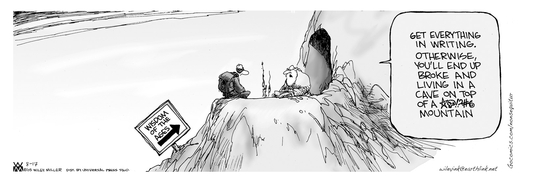5
The Process of Investment: A Matter of Trust and Mutual Interest
Whatever the type of private equity operation envisioned, the analysis of opportunities follows a common path: the progressive draft of a fair and complete portrait of the company, as well as its development perspectives. Beyond this target, this long process (from three to 18 months, depending on the complexity of the project and its stakes) also participates in the establishment of a mutual trust between investors and entrepreneurs (unlike in Cartoon 5.1). This is built slowly through the establishment of common work methods, of a dialogue of good quality and mutual esteem. Not all investments reach this ideal state, but a great deal of success in private equity is the outcome of an active partnership between investors and entrepreneurs.
Cartoon 5.1 Modern excesses and where private equity should not go...
© 2009 Wiley Miller and Universal Uclick. Reprinted by permission.

The primary analysis (see section 1) is largely conditioned by the introduction of the investment to the general partner. Depending on the scenario, and the implicit degree of trust which is associated with the intermediary, this preliminary analysis can be more or less thorough. Then, the valuation of the company and the evaluation of its development perspectives (see section 2) will help to identify what would be the potential profit attached ...
Get Introduction to Private Equity now with the O’Reilly learning platform.
O’Reilly members experience books, live events, courses curated by job role, and more from O’Reilly and nearly 200 top publishers.

